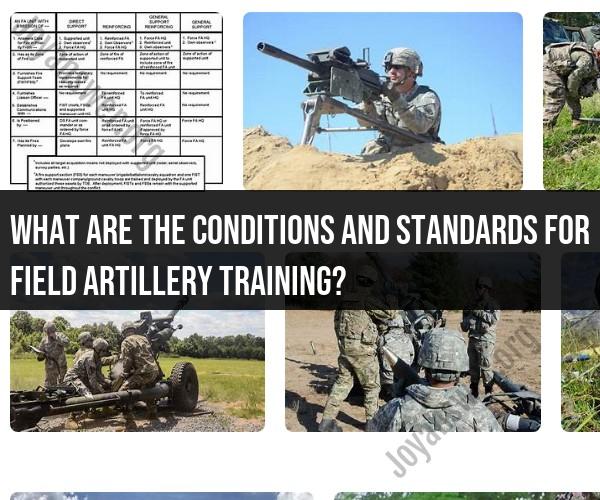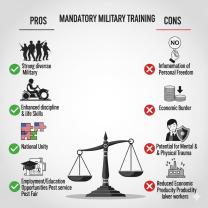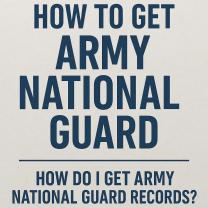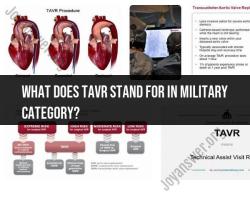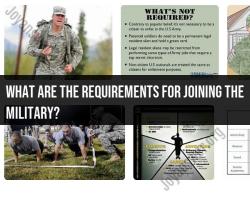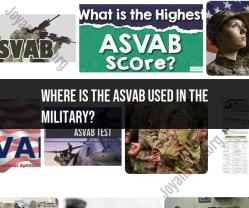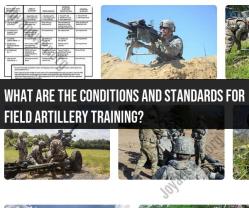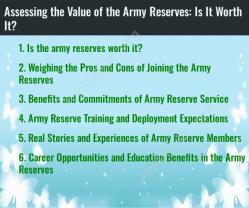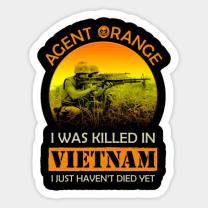What are the conditions and standards for field artillery training?
Field artillery training in the military, whether it's in the U.S. Army or another armed force, adheres to specific conditions and standards to ensure the safety, effectiveness, and readiness of artillery units. These conditions and standards can vary based on the military branch, specific equipment, and operational requirements., here are some general conditions and standards that may apply to field artillery training:
Safety: Safety is paramount in field artillery training. All training activities must adhere to strict safety protocols to prevent accidents and injuries.
Equipment Maintenance: Field artillery units are responsible for ensuring their equipment, including howitzers, vehicles, and associated gear, is well-maintained and operational.
Live Fire Exercises: Artillery crews must follow precise procedures during live fire exercises, including range safety, ammunition handling, and proper gunnery techniques.
Ammunition Handling: Strict protocols are in place for the handling, transportation, and storage of artillery ammunition to prevent accidents or mishandling.
Environmental Considerations: Training exercises should be conducted with respect for the environment and adhere to environmental protection standards, including the disposal of hazardous materials.
Artillery Drill and Procedures: Crews must be proficient in artillery drill and procedures, including loading, aiming, and firing the howitzer, as well as conducting rapid crew drills.
Communication: Effective communication within and between artillery crews is critical. Soldiers must be trained to use the appropriate communication equipment and protocols.
Fire Direction Control: Proper training in fire direction control ensures accurate targeting and safety during artillery fire missions.
Fire Support Planning: Artillery units must be skilled in integrating with other combat arms and planning for fire support in various operational scenarios.
Operational Security (OPSEC): Training should incorporate OPSEC measures to protect sensitive information and prevent the compromise of mission details.
Field Operations: Artillery crews must be trained in field operations, including establishing firing positions, conducting surveys, and maintaining situational awareness.
Live Fire Certification: Soldiers and crews often undergo live fire certification exercises to demonstrate their proficiency in handling and firing artillery systems.
Tactical Proficiency: Artillery units should be trained in tactics and strategies relevant to their mission, including counter-battery fire, suppression, and support of maneuver units.
Logistical Support: Adequate logistical support, including resupply, maintenance, and medical care, must be available during training exercises.
It's important to note that field artillery training standards and conditions may evolve over time, and there can be variations between different military branches and countries. Therefore, for the most current and specific information on field artillery training, it's essential to refer to the training manuals, regulations, and directives provided by the military organization in question. Additionally, training may be influenced by operational requirements and the evolving nature of warfare and technology.
What are the conditions and standards for field artillery training in the military?
Field artillery training in the military is conducted under a variety of conditions, including:
- Weather: Hot and cold weather, rain and snow, day and night
- Terrain: Mountains, deserts, and forests
The standards for field artillery training are high. Artillerymen must be able to:
- Quickly and accurately deploy their weapons
- Fire on targets at long ranges
- Work effectively as part of a team
- Communicate clearly under pressure
- Make sound decisions in fast-paced and stressful environments
How does field artillery training differ from other military training programs?
Field artillery training differs from other military training programs in a number of ways. First, artillerymen must learn how to operate and maintain complex weapons systems, such as howitzers and rocket launchers. Second, artillerymen must learn how to work as part of a team to coordinate fire on targets. Third, artillerymen must be able to operate in a variety of challenging conditions, often under heavy fire.
What are the physical fitness requirements for field artillery training?
Field artillery training is physically demanding. Artillerymen must be able to:
- Carry heavy loads
- Move quickly over rough terrain
- Operate heavy weapons systems
- Sustain prolonged periods of physical activity
The specific physical fitness requirements for field artillery training vary depending on the branch of service and the specific job. However, all artillerymen must be able to meet the minimum physical fitness standards for their branch of service.
Are there specific safety protocols during field artillery training?
Yes, there are a number of specific safety protocols that must be followed during field artillery training. These protocols are designed to prevent accidents and injuries.
Some of the most important safety protocols include:
- Always wearing proper eye and ear protection when handling or firing artillery weapons
- Never pointing an artillery weapon at someone, even if it is unloaded
- Always following the commands of your instructor when handling or firing artillery weapons
- Be aware of your surroundings and take precautions to avoid accidents
How long does field artillery training typically last?
The length of field artillery training varies depending on the branch of service and the specific job. However, most field artillery training programs last for several weeks or months.
For example, the U.S. Army's Field Artillery Basic Course lasts for 10 weeks. This course covers a variety of topics, including artillery weapons systems, fire control systems, and gunnery procedures.
After completing basic training, artillerymen may receive additional training in specific areas, such as radar operations or fire control systems. This additional training can last for several weeks or months.
Once artillerymen have completed their training, they are assigned to artillery units around the world. They are responsible for providing artillery support to infantry and armored units.
Conclusion
Field artillery training is a challenging but rewarding experience. Artillerymen play a vital role in the military, and they learn valuable skills that can be used in both civilian and military careers.
